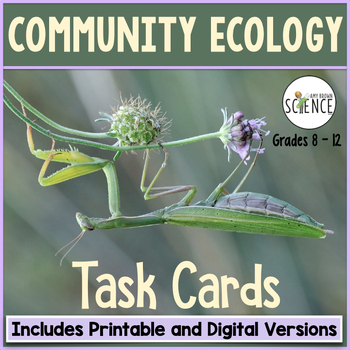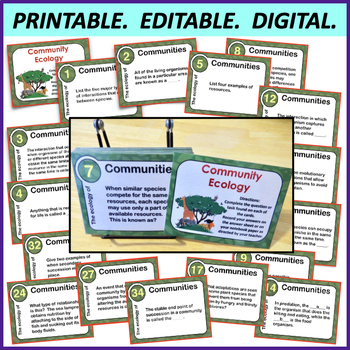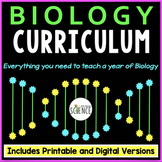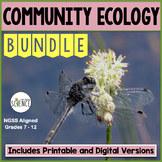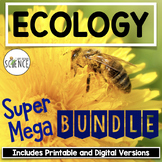Habitats and Communities Ecological Relationships Community Ecology Task Cards
- Zip
- Google Apps™

Also included in
- This NO PREP, PRINTABLE, EDITABLE, AND DIGITAL Biology Curriculum contains everything you need for an entire year of Biology! For less than $3 a day, you can save your time, energy, and sanity. Each of the 20 Complete Units includes a teaching PowerPoint presentation, notes, labs, homework assignmenPrice $525.00Original Price $988.18Save $463.18
- This printable, editable, and digital bundle of resources on Community Ecology covers community interactions, such as competition, symbiosis, predator-prey relationships, ecological disturbances and succession. Please complete list of topics below. This bundle includes everything you need to teach aPrice $29.50Original Price $38.49Save $8.99
- All of my ecology and environmental science resources (6 ecology unit bundles) are included in this one Super-Mega-Bundle! This mega-bundle includes all of the PowerPoints, notes, labs, task cards, homework assignments, review games, quizzes, activities, and unit tests that you need to teach a compPrice $178.00Original Price $252.64Save $74.64
Description
This is a set of 36 enrichment and review task cards for your lessons on Community Ecology. Students will explore community interactions such as competition, resource partitioning, predation, mimicry, and symbiosis. Students will apply their critical thinking skills to the concepts of mutualism, parasitism, commensalism, and primary and secondary succession. Key vocabulary words are thoroughly covered. Printable and digital versions are included. The questions cover all the topics you would expect to find in a traditional high school biology textbook. A detailed list of the topics covered can be found below.
Both printable and digital versions of this resource are included. The student handouts and task cards can be printed or used in the paperless digital format in your Google Drive, Google Classroom, Microsoft OneDrive, or similar.
Both Google Slides and Google Forms versions are included.
Suitable for biology students in grades 9 - 12. This resource is perfect for traditional classroom settings, 1:1 schools, or for distance learning.
The task cards were written to accompany my Community Ecology Powerpoint and Notes Set, but they can easily and appropriately be used with any unit studying communities.
What is included in this resource?
- A set of 36 FULL COLOR, printable, and editable task cards.
- A set of 36 LOW INK, printable, and editable task cards.
- Paperless Digital Versions for use in Google Drive, Google Classroom, and/or Microsoft OneDrive.
- Google Slides version (not editable)
- Google forms version (editable)
- A student answer sheet for recording answers.
- Blank task cards so that you can add additional questions.
- Teacher Guide containing tips, directions, and suggestions.
- A complete teacher answer key.
- A teacher answer key PowerPoint that can be used to go over answers with the students.
Task cards are a fantastic way to enrich or reinforce lessons, review difficult concepts, or provide extra practice for the struggling student. The student reads each card, performs the task, and records his/her answer on the included student answer sheet.
From the moment of purchase, you will be ready to use your task cards in just a few minutes. Simply print the sheets of task cards on card stock paper, laminate, and cut the cards apart. The cards look best when printed in color, but they can easily be printed in black and white.
Topics covered in this unit test are:
- Community Interactions: Definition of community, types of community interactions such as competition, predation, symbiosis, mutualism, commensalism, and parasitism.
- Competition: Definition of competition, definition of resource, the competitive exclusion principle, character displacement, many examples, resource partitioning, the result of organisms having identical niches.
- Predation: Definition, examples, predator, prey, the role of natural selection, adaptations found in predators, adaptations found in prey, mimicry, adaptations found in plants and herbivores.
- Symbiosis: Definition of symbiosis, types of symbiosis, mutualism, commensalism, parasitism, many examples of each.
- Properties of Communities: Species richness and diversity, definition of species richness, definition of species diversity, the species-area effect, the result of habitat destruction.
- Succession: Disturbances, definition and examples of disturbances, definition of succession, types of succession, primary succession, examples of primary succession, secondary succession, examples of secondary succession, pioneer species, climax communities.
Related products include:
Introduction to Ecology PowerPoint with Notes for Teacher and Student
Population Ecology PowerPoint with Notes for Teacher and Student
Food Chains and Food Webs Activity
Ecosystems and the Biosphere Part 2: Biomes of the World PowerPoint and Notes
Human Impact on the Environment PowerPoint and Notes Set
FREE Set of Six Ecology Crossword Puzzles
Lichens: Informational Text, Critical Reading and Lab Activity
FREE! Backyard Ecology: An Ecological Assessment of Your Back Yard
Graphing and Data Analysis Activity on the Symbiotic Relationships of Mycorrhizae
Community Ecology Quiz / Review Worksheet
Community Ecology REVIEW Powerpoint of 50 Questions/Answers
Community Ecology Homework and Study Guide
Predator Prey Informational Text and Graphing Activity
For updates about sales and new products, please follow my store:

